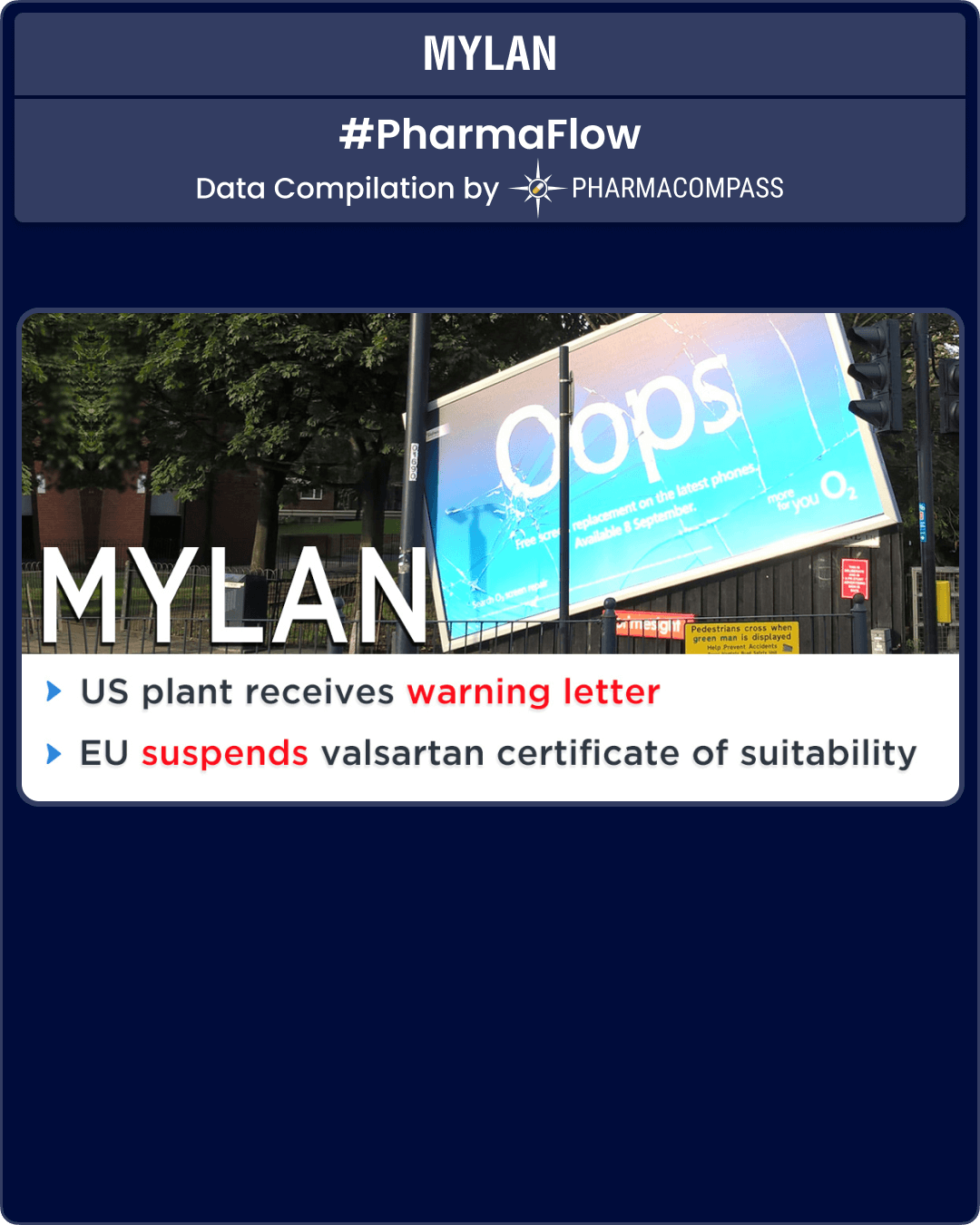
By PharmaCompass
2018-11-22
Impressions: 3100
In August this year, American generic drug major Mylan posted disappointing second-quarter results and slashed its full-year guidance. During its earnings call, the company had said it has formed a strategic review committee to look at every available option, given the fall in its US operations by 22 percent due to lower volumes on existing products.
This week Mylan’s troubles got deeper, as the US Food and Drug Administration (FDA) issued a warning letter to its manufacturing site in Morgantown, West Virginia.
The mess at Morgantown
This year, from March 19 to April 12, the FDA completed an inspection of Mylan’s main manufacturing site in Morgantown. The Form 483 issued to the company had highlighted serious quality concerns ranging from the lack of oversight by the quality unit to cross contamination concerns.
According to a list of laboratory investigations generated during the inspection, 4,279 out of 25,432 investigations were not closed by quality assurance (QA) prior to batch release. Of these open investigations, 1,945 investigations were for in-process results that were out of specification.
The news about the troubles at the Morgantown site is not new, and the company has been taking remedial measures. Mylan had announced it had undertaken a restructuring and remediation program in Morgantown during the second quarter of 2018. The program, which includes discontinuation of a number of products, is aimed at reducing complexity at the facility.
In April, Mylan had also announced layoffs of about 15 percent of its workforce at its Morgantown plant. The firm said the plant “needed to be rightsized to be less complex” for continued operations. The layoffs involved 400 people.
Quality
systems at facilities in India also questioned
In the warning letter, the FDA not only highlighted the same concerns mentioned in the Form 483, but also questioned the quality system at Mylan’s other facilities.
The warning letter said: “Your inspectional history and significant findings in this letter indicate that your quality unit is not fully exercising its authority and/or responsibilities. For example, your quality unit failed to ensure that cleaning operations are adequate to prevent cross-contamination; manufacturing changes are appropriately evaluated; manufacturing processes are robust and capable of consistently delivering quality product; and investigations are effective. Your firm must provide the quality unit with the appropriate authority, sufficient resources, and staff to carry out its responsibilities and consistently ensure drug quality.”
The FDA cited similar cGMP (current good manufacturing practices) violations at Morgantown and other facilities in the company’s network. Since 2015, FDA has taken the following actions in response to cGMP violations at Mylan facilities.
• On August 6, 2015, three Mylan facilities (in Karnataka, India) were issued a combined warning letter for (among other things) inadequate controls for manufacturing sterile drugs; failure to establish scientifically sound and appropriate laboratory controls; and failure to thoroughly investigate unexplained discrepancies.
• On April 3, 2017, a Mylan facility in Nashik (India) was issued a warning letter for (among other things) invalidating numerous initial OOS assay results without sufficient investigations to determine the root cause of the initial failure.
“These repeated failures at multiple sites demonstrate that Mylan’s management oversight and control over the manufacture of drugs is inadequate,” the FDA said, in its recent warning letter.
EU suspends Mylan’s valsartan certificate of suitability (COS/CEP)
After the warning letter, there was more trouble waiting for the maker of EpiPens. Authorities in the EU are taking action after an impurity, N-nitrosodiethylamine (NDEA), was found in some batches of valsartan made by Mylan Laboratories Limited in Hyderabad, India.
Both NDEA and N-nitrosodimethylamine (NDMA) found in ‘sartans’ made by several manufacturers over the last few months, are classified as probable human carcinogens (substances that could cause cancer).
The European Directorate for the Quality of Medicines and Healthcare (EDQM) has suspended the certificate of suitability to the monographs of the European Pharmacopeia (CEP) for Mylan’s facility in Hyderabad.
CEP is a certificate of compliance with European standards for quality testing. The suspension of CEP effectively prohibits the use of valsartan made by Mylan’s India facility in EU medicines.
National authorities in the EU have also started recalling affected batches of medicines containing Mylan’s valsartan and are conducting further tests to determine the extent of the contamination.
In the United States, Mylan announced a voluntary nationwide recall of select lots of Valsartan-containing products, including six lots of Amlodipine and Valsartan Tablets, seven lots of Valsartan Tablets, USP and two lots of Valsartan and Hydrochlorothiazide Tablets, USP 320mg/25mg strength.
EMA is reviewing the blood pressure medicines candesartan, irbesartan, losartan, olmesartan and valsartan in relation to impurities found in some batches of these medicines.
The presence of impurities in valsartan medicines and other sartans is thought to be linked to the synthesis of a specific ring structure (tetrazole) which is present in some sartan medicines.
EMA's review of sartans is continuing and the agency is working closely with national authorities, international partners and the EDQM.
The review will evaluate the root cause for the presence of these impurities, their possible impact on patients and measures that can be taken to reduce or eliminate these impurities from future batches of sartans.
The PharmaCompass Newsletter – Sign Up, Stay Ahead
Feedback, help us to improve. Click here
Image Credit : OOPS by Gordon Joly is licensed under CC BY 2.0 // Modification: Mylan text was added to the original image.
“ The article is based on the information available in public and which the author believes to be true. The author is not disseminating any information, which the author believes or knows, is confidential or in conflict with the privacy of any person. The views expressed or information supplied through this article is mere opinion and observation of the author. The author does not intend to defame, insult or, cause loss or damage to anyone, in any manner, through this article.”








